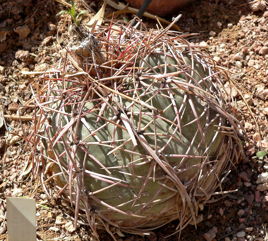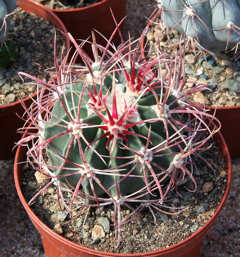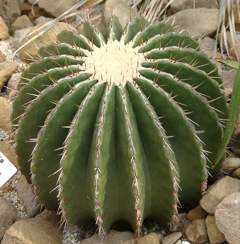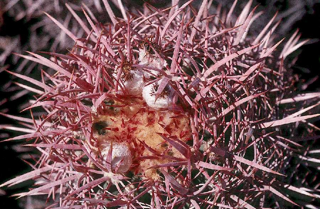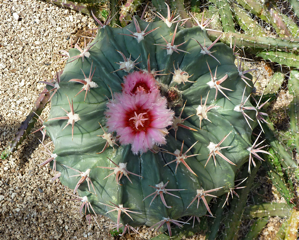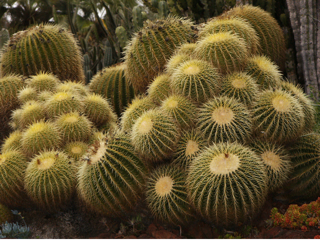Submitted by: Maria Capaldo
Echinocactus is a genus of cacti in the subfamily Cactoideae. The generic name derives from the Ancient Greek εχινος (echinos), meaning hedgehog and cactus. It and Ferocactus are the two genera of barrel cactus. The genus of Echinocactus is widely accepted lately to include 6 species, with one exception. Historically, the name Echinocactus has included many hundreds of species. Taxonomists and most recently, DNA analysis, has redefined the genus. Members of the genus usually have an overall barrel shape with well-defined ribs and heavy spination. They develop a dense, fuzzy wool at the apex which gives rise to the flowers in mature plants. This can be a wide, flat area covering almost the whole top of the plant in Kroenleinia (=E.) grusonii and E. platyacanthus or very limited and hardly noticeable as in E. texensis. The fruits are copiously woolly, and this is one major distinction between Echinocactus and Ferocactus. Propagation is by seed.
Perhaps the best known species is the “golden barrel” (Echinocactus grusonii) from Mexico, which has been found to have a DNA pattern that is probably derived from hybrids between Echinocactus and Ferocactus. To correct this, Echinocactus grusonii has been moved to its own genus, and the correct name would be Kroenleinia (=Echinocactus) grusonii. It is an easy-to-grow and widely cultivated plant. Varieties include albispsinus (white or nearly white spines), brevispinus or inermis (mutant with short spines). Though common in the houseplant and landscape industry, grusonii has become very rare in habitat.
The remaining 5 species are indigenous to the Southwestern United States and Mexico.
LATIN LOOKUP – Loquerisne Latine (Do you speak Latin)?
The meanings of latin plant names on this page – from http://davesgarden.com/guides/botanary/
- Echinocactus [ek-in-oh-KAK-tus]
From the Greek echinos (porcupine, hedgehog) and cactus, referring to its spines. - Ferocactus [fer-oh-KAK-tus]
From the Latin ferus, (fierce) and cactus, referring to its heavy spines. - grusonii [groo-SON-ee-eye]
Named for Hermann Gruson, 19th century German collector, nurseryman in Magdeburg. - parryi [PAIR-ree-eye]
Named for Dr. Charles Christopher Parry, 19th century English-born American botanist and collector with the Pacific Railway Survey. - platyacanthus [plat-ee-a-KAN-thus]
From the Greek platys (broad) and kantha (thorn). - polycephalus [pol-ee-SEF-a-lus, pol-ee-KEF-a-lus]
Many-headed. - texensis [teck-SEN-sis]
Of or from Texas (U.S.).
